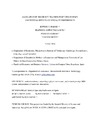Identificador persistente para citar o vincular este elemento:
https://accedacris.ulpgc.es/jspui/handle/10553/35751
| Campo DC | Valor | idioma |
|---|---|---|
| dc.contributor.author | Harris, Jeffrey E. | en_US |
| dc.contributor.author | Lopez-Valcarcel, Beatriz G. | en_US |
| dc.contributor.author | Barber, Patricia | en_US |
| dc.contributor.author | Ortún, Vicente | en_US |
| dc.contributor.other | Ortun, Vicente | - |
| dc.contributor.other | Valcarcel, Bea | - |
| dc.contributor.other | Barber, Patricia | - |
| dc.date.accessioned | 2018-05-08T13:20:24Z | - |
| dc.date.available | 2018-05-08T13:20:24Z | - |
| dc.date.issued | 2017 | en_US |
| dc.identifier.issn | 1057-9230 | en_US |
| dc.identifier.uri | https://accedacris.ulpgc.es/handle/10553/35751 | - |
| dc.description.abstract | In Spain's `MIR' system, medical school graduates are ranked by their performance on a national exam and then sequentially choose from the available residency training positions. We took advantage of a unique survey of participants in the 2012 annual MIR cycle to analyze preferences under two different choice scenarios: the residency program actually chosen by each participant when it came her turn (the 'real') and the program that she would have chosen if all residency training programs had been available (the 'counterfactual'). Utilizing conditional logit models with random coefficients, we found significant differences in medical graduates' preferences between the two scenarios, particularly with respect to three specialty attributes: work hours/lifestyle, prestige among colleagues, and annual remuneration. In the counterfactual world, these attributes were valued preferentially by those nearer to the top, while in the real world, they were valued preferentially by graduates nearer to the bottom of the national ranking. Medical graduates' specialty preferences, which we conclude, are not intrinsically stable but depend critically on the 'rules of the game'. The MIR assignment system, by restricting choice, effectively creates an externality in which those at the bottom, who have fewer choices, want what those at the top already have. | en_US |
| dc.language | eng | en_US |
| dc.relation.ispartof | Health Economics | en_US |
| dc.source | Health Economics (United Kingdom)[ISSN 1057-9230],v. 26, p. 371-386 | en_US |
| dc.subject | 531207 Sanidad | en_US |
| dc.subject.other | Medical residency | en_US |
| dc.subject.other | Mixed logit | en_US |
| dc.subject.other | Physician income | en_US |
| dc.subject.other | Professional prestige | en_US |
| dc.subject.other | MIR system | en_US |
| dc.subject.other | Independence of irrelevant alternatives | en_US |
| dc.title | Allocation of residency training positions in Spain: contextual effects on specialty preferences | en_US |
| dc.type | info:eu-repo/semantics/Article | en_US |
| dc.type | Article | en_US |
| dc.identifier.doi | 10.1002/hec.3318 | |
| dc.identifier.scopus | 84959017521 | - |
| dc.identifier.isi | 000394647400007 | - |
| dcterms.isPartOf | Health Economics | |
| dcterms.source | Health Economics[ISSN 1057-9230],v. 26 (3), p. 371-386 | |
| dc.contributor.authorscopusid | 7407317585 | - |
| dc.contributor.authorscopusid | 57210243782 | |
| dc.contributor.authorscopusid | 6507677112 | - |
| dc.contributor.authorscopusid | 7102119002 | - |
| dc.contributor.authorscopusid | 56415170600 | - |
| dc.identifier.eissn | 1099-1050 | - |
| dc.description.lastpage | 386 | - |
| dc.identifier.issue | 3 | - |
| dc.description.firstpage | 371 | - |
| dc.relation.volume | 26 | - |
| dc.investigacion | Ciencias Sociales y Jurídicas | en_US |
| dc.type2 | Artículo | en_US |
| dc.identifier.wos | WOS:000394647400007 | - |
| dc.contributor.daisngid | 1409086 | - |
| dc.contributor.daisngid | 7008994 | |
| dc.contributor.daisngid | 1229412 | - |
| dc.contributor.daisngid | 3537283 | - |
| dc.contributor.daisngid | 1148221 | - |
| dc.identifier.investigatorRID | A-2078-2009 | - |
| dc.identifier.investigatorRID | A-9891-2010 | - |
| dc.identifier.investigatorRID | B-4788-2017 | - |
| dc.contributor.wosstandard | WOS:Harris, JE | |
| dc.contributor.wosstandard | WOS:Lopez-Valcarcel, BG | |
| dc.contributor.wosstandard | WOS:Barber, P | |
| dc.contributor.wosstandard | WOS:Ortun, V | |
| dc.date.coverdate | Marzo 2017 | |
| dc.identifier.ulpgc | Sí | es |
| dc.description.sjr | 1,533 | |
| dc.description.jcr | 2,319 | |
| dc.description.sjrq | Q1 | |
| dc.description.jcrq | Q1 | |
| dc.description.scie | SCIE | |
| dc.description.ssci | SSCI | |
| item.grantfulltext | open | - |
| item.fulltext | Con texto completo | - |
| crisitem.author.dept | GIR Economía de la salud y políticas públicas | - |
| crisitem.author.dept | Departamento de Métodos Cuantitativos en Economía y Gestión | - |
| crisitem.author.dept | GIR Economía de la salud y políticas públicas | - |
| crisitem.author.dept | Departamento de Métodos Cuantitativos en Economía y Gestión | - |
| crisitem.author.orcid | 0000-0002-5571-3257 | - |
| crisitem.author.orcid | 0000-0001-8904-8358 | - |
| crisitem.author.parentorg | Departamento de Métodos Cuantitativos en Economía y Gestión | - |
| crisitem.author.parentorg | Departamento de Métodos Cuantitativos en Economía y Gestión | - |
| crisitem.author.fullName | González Lopez-Valcarcel, Beatriz | - |
| crisitem.author.fullName | Barber Pérez, Patricia Lucía | - |
| Colección: | Artículos | |
Citas SCOPUSTM
3
actualizado el 08-jun-2025
Citas de WEB OF SCIENCETM
Citations
2
actualizado el 08-jun-2025
Visitas
138
actualizado el 31-oct-2024
Descargas
283
actualizado el 31-oct-2024
Google ScholarTM
Verifica
Altmetric
Comparte
Exporta metadatos
Los elementos en ULPGC accedaCRIS están protegidos por derechos de autor con todos los derechos reservados, a menos que se indique lo contrario.
